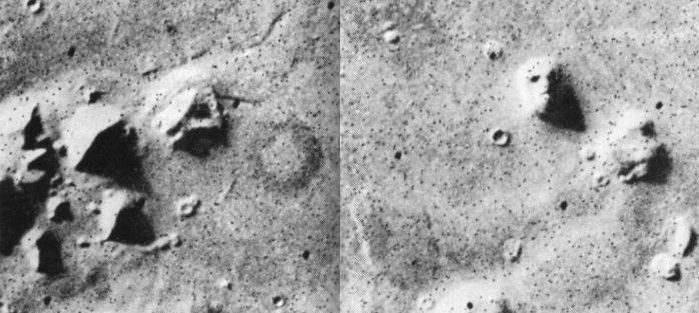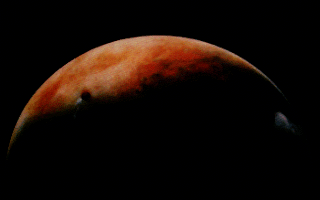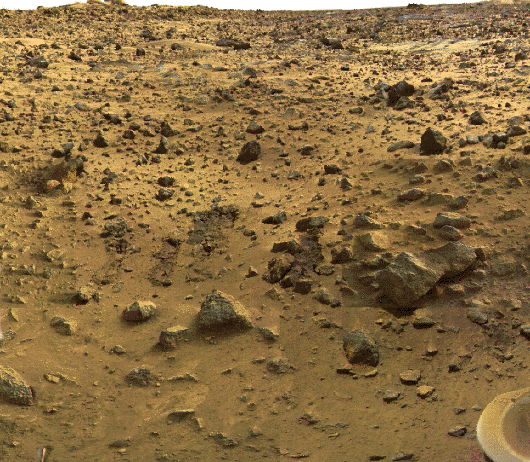 |
|
The Face on Mars
Viking Photos
|
|
|
Viking 1 took the first main images of
Cydonia - 35A72 and 70A13 in 1976.
|
|
|

|
|
The Overlooked Images
In 1976, Viking 1 was the much anticipated next logical step after the
Mercury and Apollo missions.
On this groundbreaking survey, the primitive probe/spacecraft took many
thousands of pictures red planet's features and sent them back to NASA.
On July 25th, Tobias Owen of JPL was going over the data from Viking 1,
for possible landing sites for Viking 2, when he came across a glimpse
of history.
"Oh my god, look at this! That looks like a face!" he said, as he
examined frame 35A72 (below),
a solitary structure reminiscent of the Sphinx, staring serenely out
into space.
In a press conference later that same day, Viking project spokesman
Gerry Soffen coined the famous phrase "trick of light and shadow"
- and claimed that just a few hours later, the image no longer appeared
to be a face
- casually dismissing perhaps one of the greatest discoveries of all
time.
This was, in fact, a lie - there were no pictures taken of Cydonia a
few hours later, as night had fallen on that side of the rusty planet.
Any "later" photograph proving that the mound in no way resembled a
human face was not to be forthcoming
- and if any other Cydonian images were ever shot, the matter was not
discussed openly.
There were to be no further images released to the public until Mars
Global Surveyor - on May 5, 1998.
|
|
|
|
| JPL Press release on The Face on Mars - July 31, 1976
|
|
This picture is one of many taken in the northern latitudes of Mars by
the Viking 1 orbiter in search of a landing site for Viking 2.
The picture shows eroded mesa-like landforms.
The huge rock formation in the center, which resembles a human head, is
formed by
shadows giving the illusions of eyes, nose, and a mouth.
The feature is 1.5 kilometers (1 mile) across, with the sun angle at approximately 20 degrees.
The speckeld appearance of the image is due to bit errors, emphasized by enlargement of the photo.
The picture was taken on July 25 from a range of 1,873 kilometers (1,162 miles).
Viking 2 will arrive in Mars orbit next Saturday [August 7] with a landing scheduled for early September.
|
|
|
In the above caption, replace the possibly intentionally misleading NASA words
"shadows" with "fissures" or "indentations" - and "illusions" with "appearance."
Cydonia investigators believe that this press release was censored at the last minute
and that the original statement reflected the scientists true feelings of astonishment and
cautious celebration, regarding the surprising discovery on the first close-up photos of Mars.
Imagine how many more telling sentences might have been omitted from this announcement
regarding the first images from another planet, that just happen to reveal not one, but several,
possibly man made monuments - and suddenly the whole Cydonian issue is taken more seriously.
|
|
|
|
From: The Case for the Face - by McDaniel, Paxon, et al - p. 69
|
|
The next development was a decision from NASA
that Viking 2 would not, after all, land at Cydonia.
Apparently the site was now deemed
"unsafe." According to Carl Sagan:
44 degrees north was completely inaccessible to radar site-certification;
we had to accept a significant risk of failure with Viking 2 if it was committed to high northern latitudes. . . .
To improve the Viking options, additional landing sites, geologically very different from Chryse and
Cydonia, were selected in the radar-certified region near 4 degrees south latitude.
All this notwithstanding, it is an extraordinary fact that Viking 2
was finally set down at a latitude even higher than Cydonia.
It landed - and was almost overturned by boulders - on the distinctly
unpromising rock-strewn plain called Utopia, at 47.7 degrees north
latitude, on 3 September 1976.
Thus - for no obvious reason says James Hurtak - "a multimillion dollar
effort may have overlooked 'paydirt' and may have become a trivial
event. . . .
A poor selective factor had been used to choose an area of minor
geological and biological significance.
It was like choosing the Sahara Desert as a suitable landing site on
our own planet."
|
|
|

|
NASA Viking 1 Frame 35A72 - from the 1979 German book
Wir, vom Mars by Walter Hain
The many dots in the image above is "salt and pepper" or "bit errors" or missing-data static,
|
|
|

|
Spin Control
The whole issue of Cydonia as a possible landing site was dropped as
soon as the pictures became public.
This is quite surprising considering that it was a far better and more
interesting candidate than Utopia (where Viking 2 ultimately landed),
According to Carl Sagan: "there was a significant chance of small
quantities of liquid water there."
There can be only one reason for the sudden dismissal: they didn't want
anyone to know about the strange monuments found there.
Any proof of anything beyond what is considered to be accepted human
history would be controversial in the extreme.
But is it possible that Cydonia was not left alone, but actually highly
classified at the highest levels?
And what could already seem more ridiculous, more easily dismissed, by
serious "respectable" science?
To quote the movie Contact, ironically written by Carl Sagan, "first
rule of government spending: why have only one, when you can have two at
twice the price?"
How many missions could there possibly be that the public at large
knows nothing about?
And how many of the supposedly malfunctioned spacecraft, are actually
alive and well?
The only way that "we the people" would have gotten anything anywhere
near full disclosure from the Mars missions
would have been if all of NASA's wildest hopes and dreams had come
amazingly true
- that Mars was, as previous data had suggested, capable of supporting
life as we understood it in the 1960s and 70s.
If Mars had moss or algae, or even insects - big business would have
been instantly involved and there would certainly be people there by
now.
Imagine, another tiny island to be conquered - completely isolated from
outside interference and no pesky indeginous inhabitants
to lay claim to the wealth of resources to be found on an entire planet
- not to mention the strategic military and political values.
Perhaps science and civilization have been given a back seat to these
interests.
Ever since man began sending missions to Mars, nearly all of them have
mysteriously failed.
It seems that if they manage to make it into space at all, they break
down somehow,
or all contact is lost, or they crash onto the surface of the planet,
never to be heard from again
- sometimes under such mysterious circumstances as to raise the
eyebrows of ufologists.
One perhaps intentional effect of all this staggering disappointment is
that the public at large,
though perhaps at first intensely curious about the red planet,
ultimately has no idea of the controversial reality.
Many suspect that this was far too convenient to be true,
as it only served to decrease attention and increase the distance
between the public and that arm of the space program
- and if there really are monuments on Mars, the powers that be have no
intention of sharing that information with the general public.
It is also especially highly likely that what can be found out on the
subject is only the smallest fraction and most easily dismissable aspect
of the entire story.
Who knows - perhaps, as ufologists suggest, there really is sentient
life on Mars, occasionally shooting down whatever probes of ours they
can.
|
|
|
 |
Viking 1 Landing Site
Viking 1 landed at Chryse Planitia on July 20, 1976
just north of Valles Marineris
|
|
|
|
|



